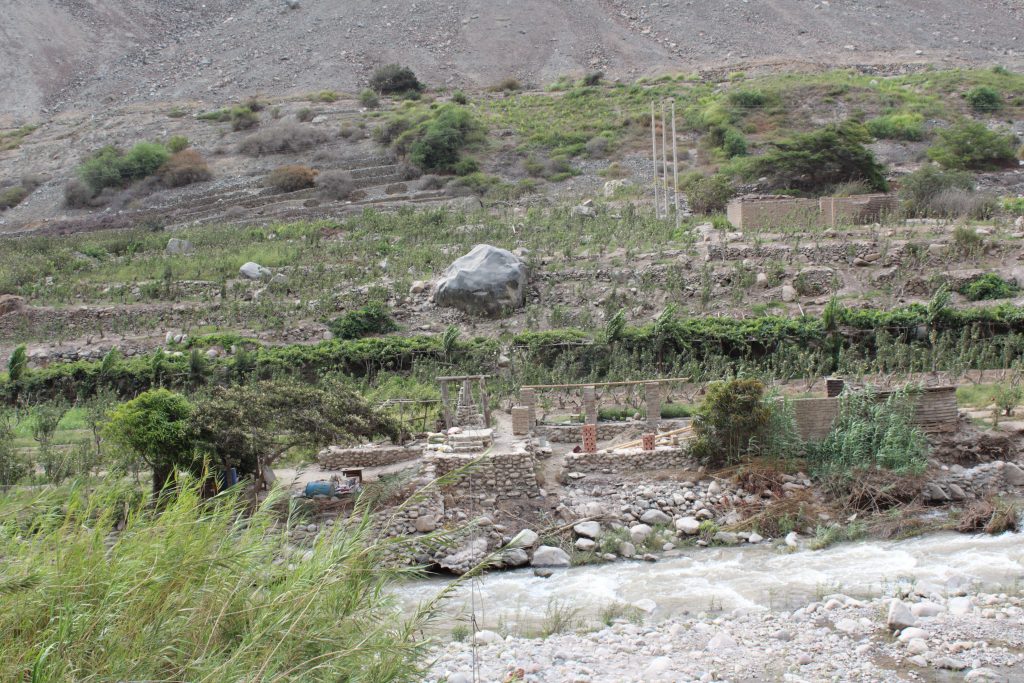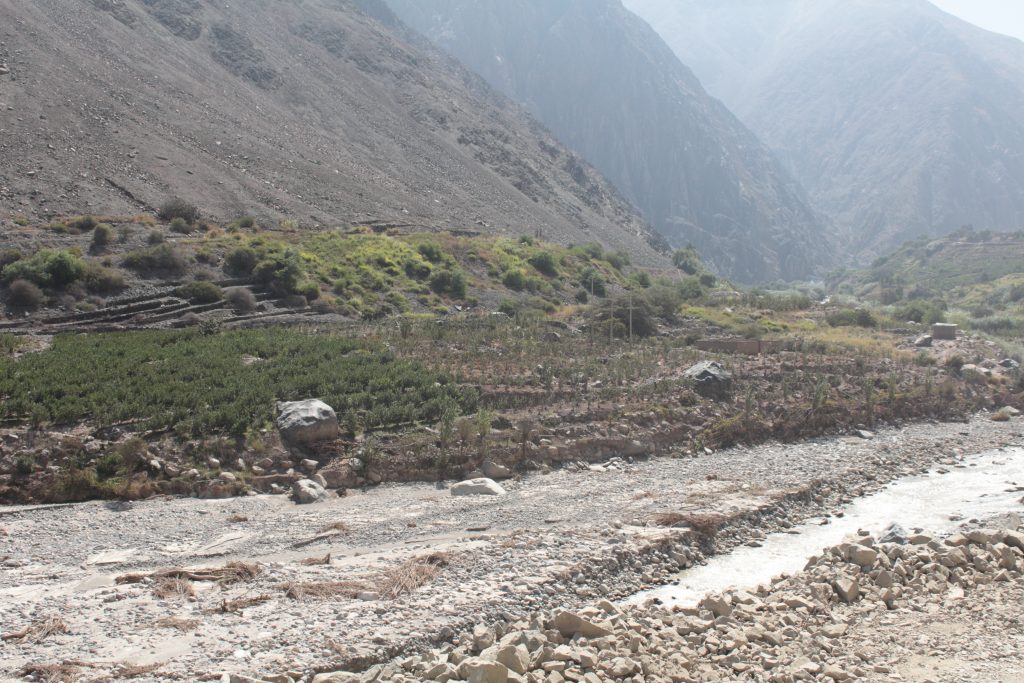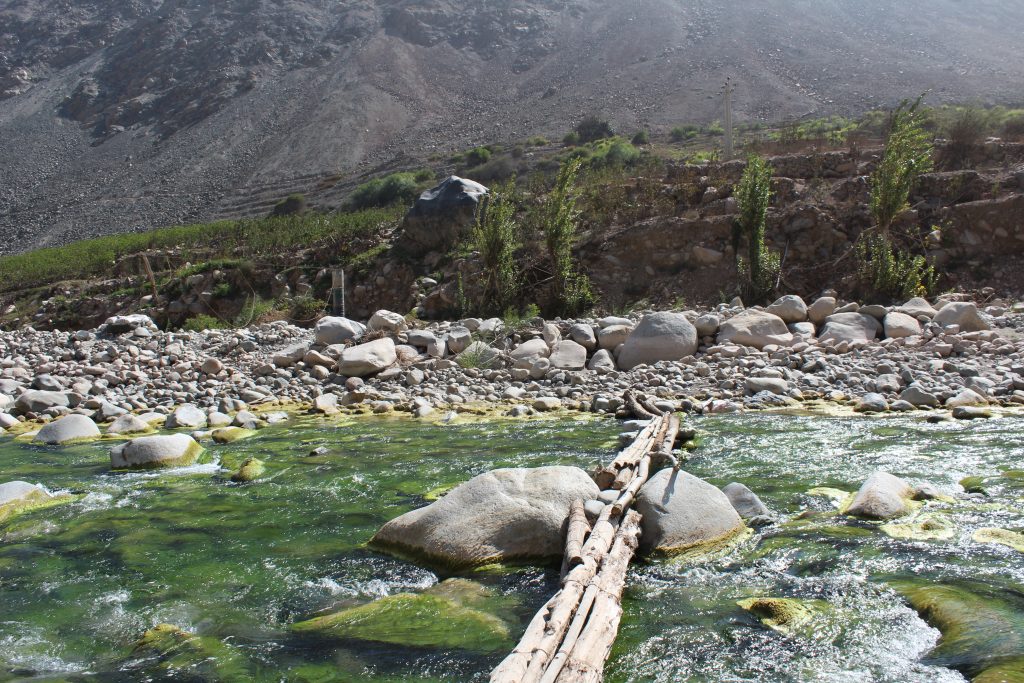The rate of flow of the Rio Mala has dropped to 3.8 cubic metres per second, according to a public website run by the water ministry. It may be possible to cross the river again.
I take a bus from Lunahuana back to Cañete and then another to Mala, arriving in the early afternoon. I stay at my usual hostal with a balcony overlooking the town square, and the owner greets me like an old friend. The next morning I wait behind the market for the one daily bus that heads up the valley to Minay. The bus is half full. People place their sacks of rice under the seat and their bundle of personal possessions above, and head off to the market to get a few essentials.
The 8 o’clock bus leaves at 9.15, with sacks of cement and wooden doors lashed to the roof, and crowbars, two-by-four and bags of shopping filling the aisle between the seats.
It takes almost an hour to reach La Capilla, seventeen kilometres up river, with several stops to drop or collect parcels. And then there is a minor panic. Someone has missed the bus! Her friend who is sitting next to me receives an anxious phone call, and rushes forward to the driver, asking him to wait. So here we rest for ten minutes. No-one objects, no-one appears to be in a hurry, and most passengers appear to know each other. It feels like a community bus.
Getting down in Retama, I look across a vast area of white boulders, pebbles and gravel through which the path of the flowing river seems narrow and calm. But as the road descends towards the river I can see that much had changed. On my first visit I walked across the river, fording two narrow strands separated by a a low bank of pebbles in the centre of the river. I passed through a wall and entered a paved patio, with columns to hold up vines. More columns were being built, and I passed through an expanse of fruit trees before I stood looking up at the face of the giant rock that confronted me.
Today the river flows entirely on the far bank. The channel has cut deep into the orchards around the stones. The walls and the patio, the vines and pillars, the walled building, the concrete block where the overhead cable across the river was tethered, all are gone.

Walking across the now dry left hand stream, I see that I am looking down on the stones from a different angle. The rampaging water has torn away the land on the right, and piled up a moraine of great boulders to a height of perhaps two or three metres on the left. The new channel runs fast and deep. A flow of 3.8 cubic metres per second, spread across the wide and shallow old river, would perhaps have been fordable, but I am looking at a torrent of water just five metres wide. There is a rickety bridge, lashed across, balanced on a central boulder. The current beneath is foaming and furious.
I see the farmer walking across his bridge with a crate of apples on his shoulders and I go to greet him.
“It has changed a lot since I was last here,” I say.
“Ah yes”.
“Your buildings and the oroya, all gone.”
“I lost seventy trees,” he replies, “and my sons and nephews lost a thousand. I was lucky. Most of my trees are higher up.”

“What happened?”
“The river came down powerfully, with boulders tearing at the earth. It was very quick, in an hour it broke everything. Afterwards the river was high, it was full of mud and rocks. It broke through the curve of the stream and it cut away at my walls. On the other side it destroyed the road. The roadway fell into the river. They cut a new path, higher up the hillside, so that the buses could pass. That is how it is.”
The major part of his orchard stood on higher ground above and behind the stones. The great twin-peaked rock now stood above a steep slope to the riverside, where before it was separated from the river by buildings, a patio and an orchard. One more huayco like that and the rock and others would drop into the riverbed.
“The patio where I had planted the vines was swept away. For five months, we could not cross the river to water the trees, I tell you.”
The oroya which they used to cross when the water was high had been swept away when the waters were at their highest.
“Twenty days ago I built this bridge with my sons. We walked far upstream to find the five tree trunks. I stood chest deep in the waters to reach the rock and lash them together.”
I wonder how many similar huaycos these stones have seen, how much the course of the river has changed. There are three giant boulders lying on the stream bed. Were these once seated on terraces above the waters? What else has swept away by this winding river over several thousand years? And how much longer will the site survive?

I wish the farmer good luck and head back downstream.
****************************************************
Emily is leaning over the wall of the yard in front of her house by the Retama stone. She is seventy, she tells me, and has lived in the same house her whole life. “In fear of the falling rocks” she says, pointing upwards to where the mountain cliffs loom above the house, giant boulders seemingly hanging loose.
“I am very poor and I have a bad heart,” she says. “Most of my land across the river has been swept away.”
Her son is working across the road in a walled orchard and she calls out to him to pick some pacay, a long green pod hanging from the upper branches of the tree, whose soft white flesh tastes of vanilla. I accept an armful of the pods and head back down the valley.
Up and down the length of the valley, it is the same, the slings crossing the river have been swept away. Farmers have been unable to reach their fields for half a year. It offers a new perspective for those Lima residents who were squealing about the price of limes for their Pisco Sours and ceviche.
***************************************
28 July 2018. President Vizcarra announces a referendum to reform the justice system and the constitution. It has four points, of which the most powerful is that no present member of Congress can serve another term. It represents a fresh start, a complete rejection of the entire Congress, and it is warmly received by the public.
Other points are restrictions on funding of political campaigns, a reform of the CNM, the National Council of Magistrates, which appoints judges and prosecutors, and a move to a two chamber legislature.
Vizcarra walks with the papers in his hand the short distance from the Presidential Palace to the Congress buildings, accompanied by press and camera crews, in a neat visualisation of his symbolic alliance with the ordinary people of Peru who have had enough of corruption.
The proposal has to be passed by Congress: they can progress a bill which will put them out of work in 2021, or they can delay or refuse. In the latter case, Vizcarra can choose to dissolve Congress and call elections. The governing majority parties in Congress, Fuerza Popular in alliance with APRA, now have national approval levels in the polls down to 15%, and disapproval over 80%, so, as it stands, they can expect to lose their jobs either in 2019 or in 2021.
Interesting choice.
